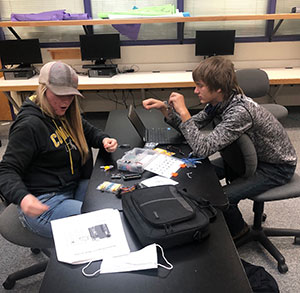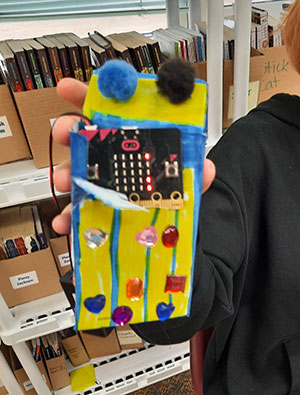
Contact Us
Institutional Communications
Bureau of Mines Building, Room 137
Laramie, WY 82071
Phone: (307) 766-2929
Email: cbaldwin@uwyo.edu
UW WySLICE Program Readies K
Published April 14, 2021

Wind River High School students Baylee Shoopman (left) and Josh Lacock work with arduinos
in James Cunningham’s computer science class. An arduino is a small computer that
has inputs and outputs. Cunningham was one of 24 Wyoming K-8 teachers or librarians
who participated in the first cohort of the WySLICE program, designed to integrate
computer science teaching into their classes by the 2022-23 school year, per a mandate
by the Wyoming Legislature. (James Cunningham Photo)
Some Wyoming K-8 teachers and librarians already have a leg up in preparation for offering computer science education in their schools come fall 2022, when it will be required. And they have the Wyoming Hub for Computer Science Outreach at the University of Wyoming to thank.
Twenty-four such educators from 11 Wyoming counties made up the first cohort year of Wyoming’s Schools and Libraries Integrating Computer Science in Education, or WySLICE. The program, funded with a $1 million National Science Foundation grant, will prepare 150 K-8 teachers and state librarians from all disciplines to integrate computer science into their classes. The curricula involve cybersecurity as well as other topics, including the use of technology in social concerns such as voting.
“We’re in the process of recruiting 40 educators for the 2021-22 cohort, and then we’ll attempt to reach 80 teachers in the final cohort year, 2022-23,” says Mike Borowczak, the Loy and Edith Harris Assistant Professor of Computer Science, who leads the WySLICE core principal investigator team for UW.
In 2019, the Wyoming Legislature mandated that computer science instruction be provided in K-12 schools by 2022. The grant application was backed with letters of support from former Gov. Matt Mead, Superintendent of Public Instruction Jillian Balow and 17 other partners.
“Basically, K-12 schools will offer computer science as part of core student knowledge starting in 2022-23,” says Andrea Burrows, a professor and associate dean in the UW College of Education. “This is an expansion of just using technology like computers and, in its place, focusing on computing skills, computational thinking and integration of computer science in other subject areas, such as science, social studies, mathematics and language arts.
“It is important to note that this does not mean that all students are required to take computer science courses, but they can if they choose to do so,” she continues. “This legislation (Senate File No. 0029 as Enrolled Act No. 48) enables K-12 students to succeed with expanded computer science skill sets and opportunities for real-world applications and future careers.”
Besides Burrows, other core principal investigators are Lars Kotthoff, a UW assistant professor of computer science; Adam Myers, a UW associate professor of physics and astronomy; and Mason Johnson, a UW graduate assistant in computer science. The project also assembles a network improvement community composed of partners from UW, community colleges, Wyoming school districts, the Wyoming State Library System, the Wyoming Department of Education and local software development firms.
The community enlists K-8 teachers from across the state to experience professional development and collaborate on integrating computer science into their instruction of science, technology, engineering, mathematics and social science topics. Because of COVID-19, the WySLICE team had to alter its original plan to go to the various schools and pivoted to meet virtually with the K-8 educators during the first year of the program.
“By and large, we value our participants’ prior experiences and backgrounds, so our professional development opportunities are generally well received since we’re not asking them ‘to do yet one more thing,’” Borowczak says. “Rather, we’re providing them opportunities to leverage what they’re already doing to explicitly showcase computational thinking and computer science within their educational spaces.”
Some Teachers Already Implementing Lessons in Classrooms
Through the WySLICE program, Sindy Joslin, who teaches fifth grade at Henderson Elementary School in Cheyenne, says she has learned how to help her students better use programming skills with micro:bits, which are pocket-sized computers that allow for creativity with digital technology.

A student in Sindy Joslin’s fifth grade class at Henderson Elementary School in Cheyenne
displays a micro:pet. Students in Joslin’s class created micro:pets and programmed
them to conduct various tasks when moved or when buttons were pushed. (Sindy Joslin
Photo)
“We first learned about robotics and what the different aspects of the micro:bit coding program -- what the different lines of code meant -- are that they will use,” says Joslin, who also is the school’s librarian. “Then, we created a code together to make a simple rock, paper, scissors game. After that, students created a micro:pet and programmed it to do various tasks when moved or when buttons were pushed.”
James Cunningham, who teaches at Wind River High School and Wind River Middle School in Riverton, also has applied what he has learned from WySLICE in his classroom. And he has gone from teaching English, math, science and any other class students need to graduate to being the sole computer science teacher at the school.
“This was an exciting move, but one that was stressful as well,” says Cunningham, who says he is not yet certified in computer science. “The school decided to offer computer science and was looking for someone to teach it. I’ve always enjoyed working with computers and took some programming classes while in high school. Having a training like WySLICE gave me the confidence to jump in this fall and start teaching computer science.”
During Halloween, Cunningham had his students choose a piece of hardware -- an arduino, Raspberry Pi or Lego Mindstorms -- and research it to a point they could teach that piece of hardware to other students. His students also have created their own personal websites using programming languages HTML and CSS, and have created a simple game using JavaScript.
While WySLICE aligns its professional development with the Wyoming computer science standards, Borowczak says he and his team stress that computer science and computational thinking are more about problem-solving than programming.
“More often than not, programming and computer science are conflated,” Borowczak says. “Our goal is to enable our state’s educators to showcase the power and need for computational skills for all of society in the 21st century.”
The 24 K-8 educators and librarians who participated in the first year of the program, listed by county, were:
Albany -- Crystal Graf, master teacher.
Campbell -- Connie Hollin, librarian.
Converse -- Jenifer Albrandt, teacher; and Jeff Kitterman, librarian.
Fremont -- Ron Chesmore, librarian; Cunningham, teacher; Kayla Horn, librarian; Nate Reinhardt, teacher; and Samantha Schwessinger, teacher.
Johnson -- Victoria Davis, master teacher; Amber McClure, teacher; Julie Snyder, teacher; and Krista Sweckard, teacher.
Laramie -- Joslin, librarian; and Michelle Ottoes, librarian.
Natrona -- Traci Blom, teacher; and Sarah Willis, teacher.
Park -- Heidi Dicks, teacher; and Shelby Randall, master teacher.
Platte -- Tesha Frederick, teacher.
Sweetwater -- Brenna Franklin, librarian.
Uinta -- Brooke George, librarian; Tim George, teacher; and Adrienne Unertl, teacher.
Dash, a miniature robot, navigates a neighborhood in Krista Sweckard’s second grade classroom at Meadowlark Elementary School in Buffalo. (Krista Sweckard Video)
Contact Us
Institutional Communications
Bureau of Mines Building, Room 137
Laramie, WY 82071
Phone: (307) 766-2929
Email: cbaldwin@uwyo.edu
